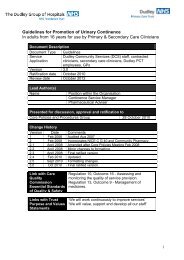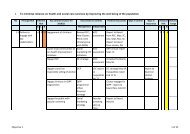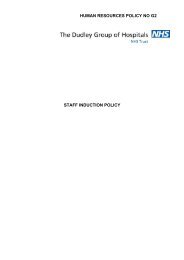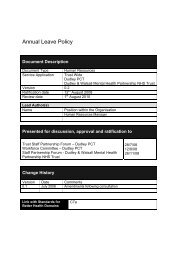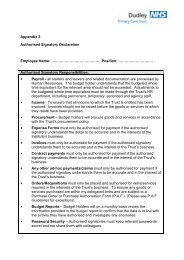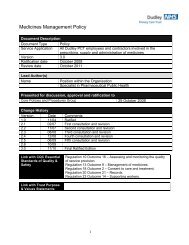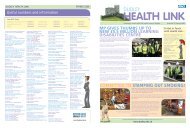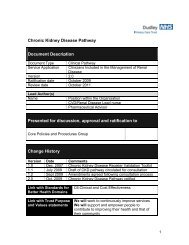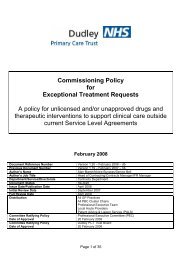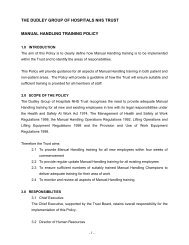Dudley Strategy for Tackling Health Inequalities 2010-15
Dudley Strategy for Tackling Health Inequalities 2010-15
Dudley Strategy for Tackling Health Inequalities 2010-15
- No tags were found...
You also want an ePaper? Increase the reach of your titles
YUMPU automatically turns print PDFs into web optimized ePapers that Google loves.
Timely ResponseApproximately 30% of patients who die of MI do so be<strong>for</strong>e reaching hospital. For theremainder, their prognosis is dependent on the time it takes to restore blood flow tothe ischaemic myocardium. The earlier reperfusion is achieved, the greater thebenefit. Mortality is twice as high in patients treated 4-6 hours after the onset ofsymptoms as it is in patients treated within 1-2 hours. There<strong>for</strong>e, it is imperative thatpatients suffering an MI should receive medical attention as quickly as possible (BHF,2006).Timely access to treatment <strong>for</strong> AMI is dependent on:o Public knowledge and awareness of signs, symptoms and speed ofresponseo Emergency response timeso Access to timely diagnostics and treatment - reperfusionPublic knowledge and awareness of the symptoms and need to call 999 is low in thegeneral population and pre-hospital delays are greater in older people, women,deprived, ethnic groups and patients with pre-existing conditions. Currently there areno national or local awareness campaigns running.Emergency reperfusion <strong>for</strong> <strong>Dudley</strong> patients is delivered by a tertiary level PrimaryPCI service <strong>for</strong> STEMI MI at the Heart and Lung Centre at New Cross Hospital(NCH) Wolverhampton. The Black Country is one of the first to roll out this service,with coverage across England currently at only 25% (MINAP, 2009). National goodpractice standards <strong>for</strong> PPCI have been set of 90 minutes between arrival atinterventional centre and reopening of artery (door to balloon) and <strong>15</strong>0 minutes fromcall <strong>for</strong> help to reopening of the artery (call to balloon). Door to balloon times aredependant on speed of access to diagnostics and treatment within the hospital andcall to balloon time incorporates ambulance response times and triage via otheradmission routes as well as hospital efficiency. Per<strong>for</strong>mance at NCH <strong>for</strong> 2008/9 wasclose to the average <strong>for</strong> England (Table 1).Table 1: Speed of Access Measures <strong>for</strong> PPCI (Source MINAP data 2009)PPCI measures ( door to balloon) (call to balloon)New cross hospital 82% 77%England average 84% 79%Source MINAP data 2009Door to balloon times are specifically influenced by the method of admission.Routine data analysis at New Cross shows a mean average door to needle time <strong>for</strong>999 ambulance admissions directly to the heart and lung centre as 67.8 minutescompared to 83.1 minutes <strong>for</strong> other admission methods e.g. via self presentation atNew Cross A&E. 28% of patients entered the pathway by the self presentation route.This reiterates the need <strong>for</strong> public awareness campaigns.Acute MI is dealt with as a Category A call with a target response time of 8 minutes.Weekly Category A response times <strong>for</strong> the WMAS during 09/10 ranged frombetween 55% to 85% with an average of 72.3%.78




